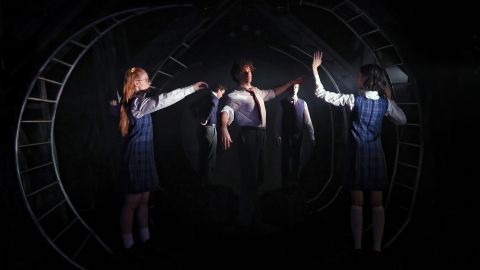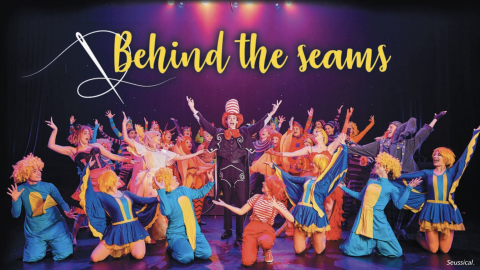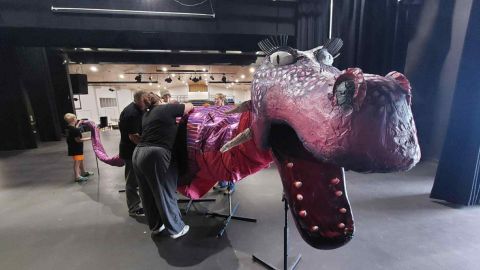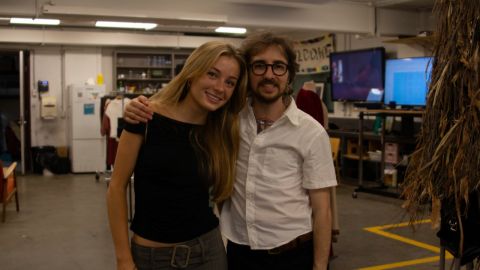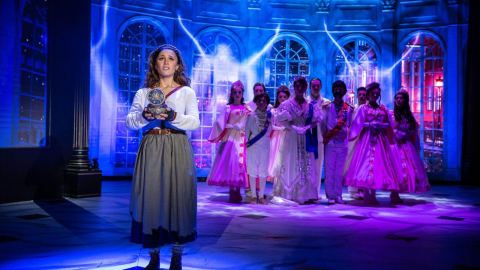HELICOPTERS FLY ACROSS AUSTRALIA AND NEW ZEALAND
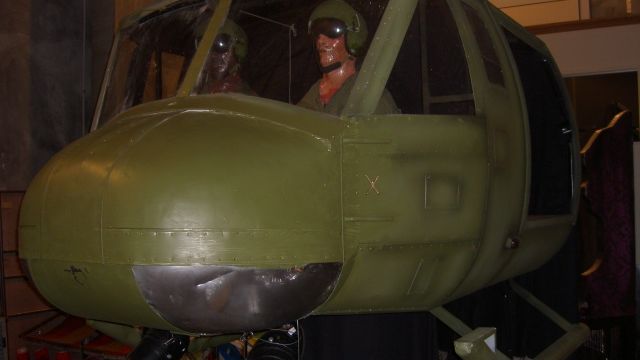
David Spicer and Sandra Davies report on how the first choppers flew in community theatre productions of Miss Saigon.
Amidst great anticipation, the first test flight of the helicopter that is going to star in productions of Miss Saigon across New Zealand for the next two years took place.
Nine community theatre companies joined forced to build a mega set. David Bosworth co-ordinated the construction in Christchurch. He makes it sound bigger than Ben Hur.
“There were four different departments,” he said. “Rob Peters from Theatre Systems Limited co-coordinated the engineering hydraulics. Panda Scenic Solutions built the frame of the helicopter. We had two artists finish the look of the ‘machine’ and my company – The Light Site - attached navigation and interior lights.”
Exactly what made the helicopter fly on stage was a closely guarded secret until opening night.
“It posed a challenge from a technical point of view,” he said. “We had to make it work in all sorts of venues, large and small. I decided we would use a staged hydraulic lifting system – rather than lowering it down from a fly tower.”
In lay mans terms, what they did was buy a small fork-lift truck and pull it apart.
“I cut it up into its various hydraulic devices, and incorporated them into a wheeled piece of scenery which we could move around the stage,” he said. “When the helicopter had to land on the embassy, the helicopter, sitting on the mast of the forklift, was pushed by a crew member.”
“The audience reaction was really good. I was worried people would see the mechanism but that was not possible. People thought the whole helicopter was used but it was only the front three metres,” he said.
Another interesting element of the helicopter is how the actors come and go out of it, whilst never actually in it when it is 'flying'. One actor is seen to jump out of the helicopter when it lands, and then beckon the evacuees into the helicopter. This actor quickly climbs up a ladder into the rear of the helicopter the moment it lands, then is seen jumping out the side door onto the 'landing pad'. The GIs all then pile into the helicopter, and immediately fling themselves down a firemen’s pole arrangement at the rear of the helicopter, prior to it 'flying away'. The fireman’s pole was used due to its compact nature (as opposed to stairs) and the speed with which we could get up to 15 actors through helicopter and out.
Overall the production was a huge commercial and artistic success. Showbiz Christchurch filled their theatre for two weeks.
In Melbourne, CLOC Music Theatre had another successful production with a similar degree of technical sophistication to the New Zealand consortium. CLOC Administrator Sandra Davies reports.
We had to create 31 different scenes representing Saigon, Bangkok and the USA – interiors, exteriors, seedy bars, brothels, street markets and parades, army headquarters, an embassy (inside and out), a conference centre, a variety of bedrooms (including four beds, which had to be constructed, assembled, made and unmade for each performance) and a dream sequence that would instantly convey Americana.
These effects were achieved by a remarkably versatile and mobile set which rotated and pivoted a full 360° and slotted together in an infinite number of configurations.
The smooth movement of the set was carefully choreographed and rehearsed by a stage crew of approximately twenty. They spent weeks rehearsing the complex and timely moves, while ensuring the cast could quickly and safely make their entrances and exits.
Two mobile set pieces were especially effective in conveying strong emotional moments during the show. The boat crowded with fleeing refugees and their meagre possessions, silhouetted against the well-known red sunset logo of Miss Saigon, made for a moving and powerful conclusion to Act 1.
And the steel gates used for the embassy dream sequence provided an imposing and overpowering sight as four sets of three metre high steel picket mobile gates filled the width of the stage, moving into different configurations representing both the inside and outside of the embassy, allowing the cast to lean, climb, and even bang on the metal gates, which added to the overwhelming sense of chaos in this scene.
And then there was the famous helicopter landing during the embassy dream sequence, which Grant Alley (Set builder) and Brenton Staples (Set Designer) were determined would be a sensual and visual highlight of the show. A lack of stage depth at the Alexander Theatre precluded using a three-dimensional helicopter or rear projection. So they used a series of three two-dimensional flats representing a helicopter, looking slightly side on from the front.
To add to the realism, the helicopter was flown over two fly bars so that it could be wobbled as it landed and took off. As it descended, a blinder light on the nose of the helicopter shone at the audience. With this and other lighting effects smoke, and a special surround sound system so that the audience felt the vibration of the rotors and the directional movement of the helicopter, the audience believed the helicopter was real.
However, the most important part of this sequence was not the helicopter, but the human pathos, powerful drama and searing emotion that was being portrayed by the cast at the gates.
CLOC had no trouble filling the many and varied Asian roles with a remarkably talented and diverse United Nations of cast members, coming from 21 different countries.
All fifteen performances were sold out. Even the programs were sold out.

